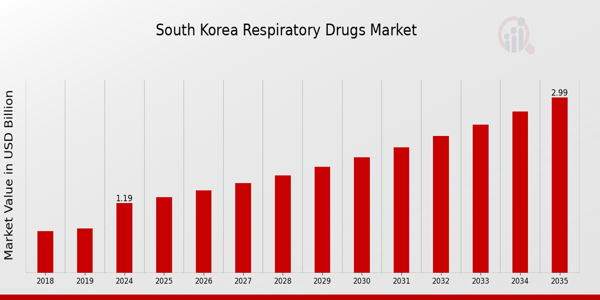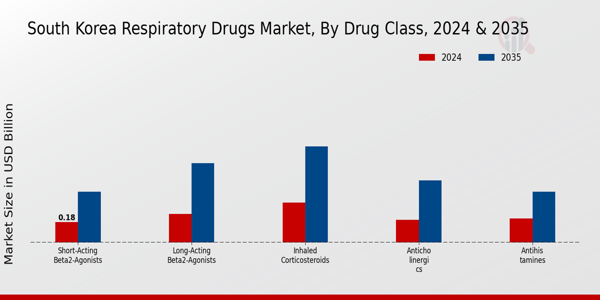South Korea Respiratory Drugs Market Overview
As per MRFR analysis, the South Korea Respiratory Drugs Market Size was estimated at 1.12 (USD Billion) in 2023.The South Korea Respiratory Drugs Market Industry is expected to grow from 1.19(USD Billion) in 2024 to 3.0 (USD Billion) by 2035. The South Korea Respiratory Drugs Market CAGR (growth rate) is expected to be around 8.752% during the forecast period (2025 - 2035)
Key South Korea Respiratory Drugs Market Trends Highlighted
The South Korea Respiratory Drugs Market is undergoing substantial trends that are influenced by a variety of factors. The demand for effective respiratory therapies has increased as a result of the rising prevalence of respiratory diseases, particularly chronic obstructive pulmonary disease (COPD) and asthma. Another significant factor is the aging population of South Korea, which is characterized by elevated rates of respiratory issues among senior adults. The government has been proactive in promoting lung health through a variety of public health initiatives, which has contributed to heightened awareness and the diagnosis of respiratory conditions, thereby further propelling market growth.
The market presents opportunities due to the increasing demand for personalized medication and the advancement of innovative drug formulations. Local pharmaceutical companies are investing in research and development to develop innovative inhalation therapies that are tailored to the unique requirements of their patients. Furthermore, the digital health growth offers a chance to integrate technology with respiratory care, providing patients with remote monitoring and management solutions. Recently, there has been an increase in the adoption of biologics and biosimilars for the treatment of respiratory diseases, which is indicative of a transition to more sophisticated therapies.
Additionally, the Covid-19 pandemic has emphasized the significance of respiratory health, leading to an increase in the demand for inhalers and other respiratory medications. South Korean companies are expanding their production capabilities to satisfy both domestic and international demands in response to this increasing demand. By encouraging local production and research initiatives, the government's supportive policies are also nurturing a conducive environment for market growth. In conclusion, these trends underscore the dynamic nature of the respiratory drugs market in South Korea, suggesting that there is substantial development potential in the years ahead.

South Korea Respiratory Drugs Market Drivers
Increasing Prevalence of Respiratory Diseases
The South Korea Respiratory Drugs Market Industry is witnessing significant growth due to the increasing prevalence of respiratory diseases, particularly chronic obstructive pulmonary disease (COPD) and asthma. According to the Ministry of Health and Welfare in South Korea, the number of asthma patients has increased by approximately 20% over the last decade, affecting around 4 million individuals. This growing patient base is driving demand for effective respiratory medications.
Established organizations such as the Korean Academy of Tuberculosis and Respiratory Diseases play a crucial role in patient awareness and education, further emphasizing the need for advanced treatments in the market. With an aging population and lifestyle changes leading to more respiratory ailments, the South Korea Respiratory Drugs Market is on a promising growth trajectory, as evidenced by healthcare investment trends aimed at improving respiratory healthcare services and drug availability.
Technological Advancements in Drug Development
Innovations in drug formulation and delivery systems are propelling the growth of the South Korea Respiratory Drugs Market Industry. New technologies such as inhalable biologics and smart inhalers are being introduced, making treatments more effective and patient-friendly. The Korean pharmaceutical industry has invested heavily in research and development, with local companies filing numerous patents related to pulmonary drug delivery systems. A report from the Korean Pharmaceutical Association highlighted that R investment in the sector increased by around 15% over the past three years.The introduction of such advanced drug delivery mechanisms not only enhances patient adherence but also boosts the overall effectiveness of treatment regimens, which are increasingly important in managing chronic respiratory diseases. As stakeholders continue to innovate, the market's future growth looks highly promising.
Government Initiatives and Support
The South Korean government has implemented various initiatives and policies aimed at improving respiratory healthcare, which contributes significantly to the South Korea Respiratory Drugs Market Industry's growth. For instance, the 'National Health Plan 2021-2025' includes specific targets for reducing the burden of respiratory diseases by promoting early diagnosis and treatment. The Korean government allocated about 3 trillion KRW for respiratory health in the 2023 budget, reflecting its commitment to enhancing healthcare services.
This investment is expected to lead to improved access to respiratory drugs and treatments, thereby fueling market growth. Support from government bodies like the Health Insurance Review and Assessment Service is also vital in ensuring that new medications are evaluated and insured promptly, facilitating faster market entry and wider accessibility for patients.
Rising Geriatric Population
The burgeoning geriatric population in South Korea is a significant driver of the South Korea Respiratory Drugs Market Industry. As per the Statistics Korea report, more than 17% of the population is expected to be aged 65 and older by 2030, leading to increased incidences of respiratory conditions often found in older adults, such as COPD and pneumonia. With this demographic shift, the demand for effective respiratory treatments is set to rise continuously.Established healthcare organizations like the Korean Geriatrics Society are advocating for enhanced respiratory care for the elderly, influencing policy and market trends in this direction. The growing need for specialized respiratory drugs tailored for older patients underscores the market's potential, as pharmaceutical companies develop specific therapies addressing the unique challenges faced by this age group.
South Korea Respiratory Drugs Market Segment Insights
Respiratory Drugs Market Drug Class Insights
The South Korea Respiratory Drugs Market showcases a diverse range of therapeutic options primarily categorized under the Drug Class segment, which plays a pivotal role in managing respiratory conditions such as asthma and chronic obstructive pulmonary disease (COPD). Among these, Short-Acting Beta2-Agonists (SABA) are notable for their quick relief of acute asthma symptoms, contributing significantly to patient adherence and satisfaction. Long-Acting Beta2-Agonists (LABA) serve the long-term management of respiratory disorders by providing sustained bronchodilation, and their consistent use helps in minimizing exacerbations.
Inhaled Corticosteroids (ICS) are fundamental in controlling inflammation in the airways; their effectiveness is bolstered by their synergy when combined with LABAs, forming a vital treatment plan for many patients.The landscape also includes Anticholinergics, which are increasingly recognized for their unique mechanism in COPD treatment, facilitating bronchodilation by blocking acetylcholine receptors. Antihistamines are primarily used to alleviate allergic reactions and have become imperative in asthma management where allergic triggers are prevalent. The role of Vasodilators in treating pulmonary hypertension adds yet another layer of complexity to the Drug Class segment, highlighting the range of drug functionalities in respiratory care.
Combination Drugs represent a significant advancement, simplifying patient regimens by integrating multiple therapeutic agents into a single inhaler, thereby enhancing compliance and optimizing treatment outcomes. Other options within this category adapt to specific patient needs, offering tailored solutions for varying respiratory conditions. This robust segmentation within the South Korea Respiratory Drugs Market not only illustrates the comprehensive approach to respiratory care but also underscores the growing demand for innovative treatments that address the multifaceted nature of respiratory disorders.
As the industry evolves, the Drug Class segment will likely continue to expand and adapt to changing patient demographics and disease prevalence, driving forward improvements in clinical outcomes and patient quality of life.

Respiratory Drugs Market Disease Type Insights
The South Korea Respiratory Drugs Market showcases a diverse classification within the Disease Type segment, focusing on significant conditions such as Asthma, Chronic Bronchitis, Chronic Obstructive Pulmonary Disease (COPD), Pleural Effusion, and others. Asthma, being one of the leading respiratory disorders, has a considerable patient base, prompting extensive drug development and research initiatives aimed at improving management and treatment protocols. Chronic Bronchitis and COPD remain substantial contributors to the morbidity and healthcare burden within South Korea, largely due to rising pollution levels and smoking prevalence.
These conditions require ongoing medical intervention and maintenance therapies, driving demand for innovative respiratory drugs. Pleural Effusion presents a unique challenge, necessitating targeted therapies for efficient management and symptom relief. With the increasing prevalence of respiratory diseases, the market's focus on these specific conditions becomes even more pertinent. The rising elderly population in South Korea along with greater awareness surrounding respiratory health signifies opportunities for growth, emphasizing the need for advanced therapeutic options catered to various respiratory ailments.Overall, this segmentation reveals key insights into the evolving landscape of the South Korea Respiratory Drugs Market.
Respiratory Drugs Market Route of Administration Insights
The Route of Administration segment within the South Korea Respiratory Drugs Market is pivotal for the effective delivery of therapeutic agents, significantly influencing patient adherence and treatment outcomes. Inhalation is the most prevalent method, primarily due to its targeted effect and rapid onset of action, making it preferable for managing acute respiratory conditions like asthma and COPD. Enteral administration, though less common, provides an alternative for patients unable to use inhalers, ensuring accessibility of treatments.
Parenteral routes are also utilized, especially in severe cases where immediate systemic effects are needed, thus enhancing the overall therapeutic efficacy.This segment's importance is underscored by the increasing prevalence of respiratory diseases in South Korea, with various government health initiatives focused on improving treatment outcomes and disease management. The South Korea Respiratory Drugs Market segmentation reflects ongoing advancements in drug formulation and delivery technologies, catering to diverse patient needs and preferences. As the market evolves, the emphasis on patient-centric approaches is likely to drive innovation in delivery methods, ultimately improving clinical results and enhancing patient quality of life.
Respiratory Drugs Market Distribution Channel Insights
The Distribution Channel segment of the South Korea Respiratory Drugs Market comprises various avenues, including Hospital Pharmacies, Retail Pharmacies, and Online Pharmacies, each playing a critical role in market dynamics. Hospital Pharmacies significantly contribute to the distribution, providing essential respiratory medications directly to patients during their healthcare experiences, ensuring optimal therapeutic intervention. On the other hand, Retail Pharmacies serve as convenient access points for patients, often offering a wide range of respiratory drugs along with personalized consultation services.
The rise of Online Pharmacies is noteworthy, propelled by increasing digitalization and consumer preference for convenience, allowing patients to easily access medications from the comfort of their homes. As South Korea experiences a higher prevalence of respiratory diseases, the importance of these distribution channels becomes even more pronounced, facilitating immediate access to necessary medications and enhancing patient adherence. Moreover, regulatory support for online medication sales is contributing to rapid growth in this segment, reflecting changing consumer behaviors and increased competition among distribution intermediaries.
The overall South Korea Respiratory Drugs Market revenue continues to benefit from these evolving distribution strategies, responding to the healthcare needs of the population effectively.
South Korea Respiratory Drugs Market Key Players and Competitive Insights
The South Korea Respiratory Drugs Market is characterized by a diverse array of players, ranging from established pharmaceutical giants to emerging biotech firms. This market is influenced by the increasing prevalence of respiratory diseases such as asthma, chronic obstructive pulmonary disease (COPD), and other related conditions, alongside a growing aging population that demands specialized treatments. Competitive dynamics are shaped by various factors, including innovation in drug formulations, advancements in delivery mechanisms, regulatory landscapes, and the strategic moves of key market participants aimed at maintaining their competitive edge.
The market is also benefitting from advancements in technology and healthcare infrastructure in South Korea, enabling better accessibility and distribution of respiratory therapies. Companies are continually investing in research and development to create more effective treatments, thereby intensifying competition and driving market growth.Daewon Pharmaceutical has established a strong foothold in the South Korea Respiratory Drugs Market through its extensive portfolio of products designed to tackle respiratory ailments. The company's strengths lie in its robust research and development capabilities, which enable it to innovate and improve existing drug formulations.
Additionally, Daewon Pharmaceutical benefits from its extensive distribution network across South Korea, ensuring that its products reach a broad customer base within the healthcare system. The company has also focused on building strong relationships with healthcare professionals and institutions, aiding in its reputation and credibility in the respiratory segment. Strong governmental support for local pharmaceutical companies further solidifies Daewon's competitive advantage, allowing for quicker responsiveness to market needs and patient requirements.Samsung Bioepis has emerged as a significant player in the South Korea Respiratory Drugs Market, known for its focus on biosimilars and biologics that address respiratory conditions.
The company is recognized for its commitment to research and innovation, which has resulted in several key products tailored for therapeutic areas related to respiratory diseases. Samsung Bioepis’ market presence is bolstered by strategic partnerships and collaborations that expand its reach and enhance its product offerings. The company's strengths include not only its extensive RD capabilities but also its aligned production and commercialization strategies that enable efficient scaling of operations. Mergers and acquisitions have played a role in enhancing its capabilities and expanding its product pipeline, further solidifying its position in the South Korean market.
The company's commitment to improving treatment options for respiratory conditions is reflected in its strategic initiatives aimed at addressing unmet medical needs, thereby enhancing its competitive stance within the industry.
Key Companies in the South Korea Respiratory Drugs Market Include
- Daewon Pharmaceutical
- Samsung Bioepis
- Hugel
- Yuhan Corporation
- LG Chem
- Pgen
- Hanmi Pharmaceutical
- MediBloc
- Severance Hospital
- DongA ST
- SK Biopharmaceuticals
- Celltrion
- Daewoong Pharmaceutical
- CJ Healthcare
- AhnGook Pharmaceutical
South Korea Respiratory Drugs Market Industry Developments
The South Korea Respiratory Drugs Market is experiencing significant developments, particularly with advancements in treatment options and the rising demand for effective respiratory therapies. Companies such as Yuhan Corporation and Samsung Bioepis are focusing on innovative drug formulations targeting respiratory conditions, which aligns with the increasing prevalence of asthma and COPD in the region. Merger and acquisition activity has been noted, with Daewoong Pharmaceutical acquiring a local biotech firm in June 2023 to enhance its research capabilities in respiratory treatments.
Additionally, the collaboration between Hanmi Pharmaceutical and MediBloc aims to leverage digital health technologies for better patient management in respiratory care, further enhancing the market landscape. Growth in market valuation has been significant, driven by an increased investment in RD and the introduction of biosimilars by Celltrion and SK Biopharmaceuticals, which are changing the competitive landscape and fostering healthier competition in the market. The overall market dynamics indicate a robust growth trajectory as healthcare investments prioritize respiratory disease management, ensuring that leading companies continue to expand their portfolios and strengthen their market positions in South Korea.
South Korea Respiratory Drugs Market Segmentation Insights
- Respiratory Drugs Market Drug Class Outlook
- Short-Acting Beta2-Agonists (SABA)
- Long-Acting Beta2-Agonists (LABA)
- Inhaled Corticosteroids (ICS)
- Anticholinergics
- Antihistamines
- Vasodilators
- Combination Drugs
- Others
- Respiratory Drugs Market Disease Type Outlook
- Asthma
- Chronic Bronchitis
- Chronic Obstructive Pulmonary Disease (COPD)
- Pleural Effusion
- Others
- Respiratory Drugs Market Route of Administration Outlook
- Inhalation
- Enteral
- Parenteral
- Respiratory Drugs Market Distribution Channel Outlook
- Hospital Pharmacies
- Retail Pharmacies
- Online Pharmacies
| Report Attribute/Metric Source: |
Details |
| MARKET SIZE 2023 |
1.12(USD Billion) |
| MARKET SIZE 2024 |
1.19(USD Billion) |
| MARKET SIZE 2035 |
3.0(USD Billion) |
| COMPOUND ANNUAL GROWTH RATE (CAGR) |
8.752% (2025 - 2035) |
| REPORT COVERAGE |
Revenue Forecast, Competitive Landscape, Growth Factors, and Trends |
| BASE YEAR |
2024 |
| MARKET FORECAST PERIOD |
2025 - 2035 |
| HISTORICAL DATA |
2019 - 2024 |
| MARKET FORECAST UNITS |
USD Billion |
| KEY COMPANIES PROFILED |
Daewon Pharmaceutical, Samsung Bioepis, Hugel, Yuhan Corporation, LG Chem, Pgen, Hanmi Pharmaceutical, MediBloc, Severance Hospital, DongA ST, SK Biopharmaceuticals, Celltrion, Daewoong Pharmaceutical, CJ Healthcare, AhnGook Pharmaceutical |
| SEGMENTS COVERED |
Drug Class, Disease Type, Route of Administration, Distribution Channel |
| KEY MARKET OPPORTUNITIES |
Growing aging population, Increased prevalence of respiratory diseases, Advancement in biologics and biosimilars, Rising demand for personalized medicine, Expansion of telemedicine solutions |
| KEY MARKET DYNAMICS |
increasing prevalence of respiratory diseases, aging population driving demand, advancements in inhaler technologies, growing awareness of chronic conditions, supportive government healthcare policies |
| COUNTRIES COVERED |
South Korea |
Frequently Asked Questions (FAQ) :
The South Korea Respiratory Drugs Market is expected to be valued at 1.19 USD billion in 2024.
By 2035, the South Korea Respiratory Drugs Market is anticipated to reach a value of 3.0 USD billion.
The CAGR for the South Korea Respiratory Drugs Market from 2025 to 2035 is expected to be 8.752 percent.
In 2024, Inhaled Corticosteroids (ICS) is projected to be the largest segment of the market, valued at 0.35 USD billion.
The market value of Short-Acting Beta2-Agonists (SABA) is expected to reach 0.45 USD billion by 2035.
Major players in the market include Daewon Pharmaceutical, Yuhan Corporation, and Celltrion among others.
In 2024, the market value for Antihistamines is estimated to be 0.21 USD billion.
The Long-Acting Beta2-Agonists (LABA) market is expected to grow to 0.7 USD billion by 2035.
The Anticholinergics segment is projected to grow from 0.2 USD billion in 2024 to 0.55 USD billion in 2035.
Challenges may include regulatory hurdles and competition from emerging therapies in the respiratory drugs sector.
















